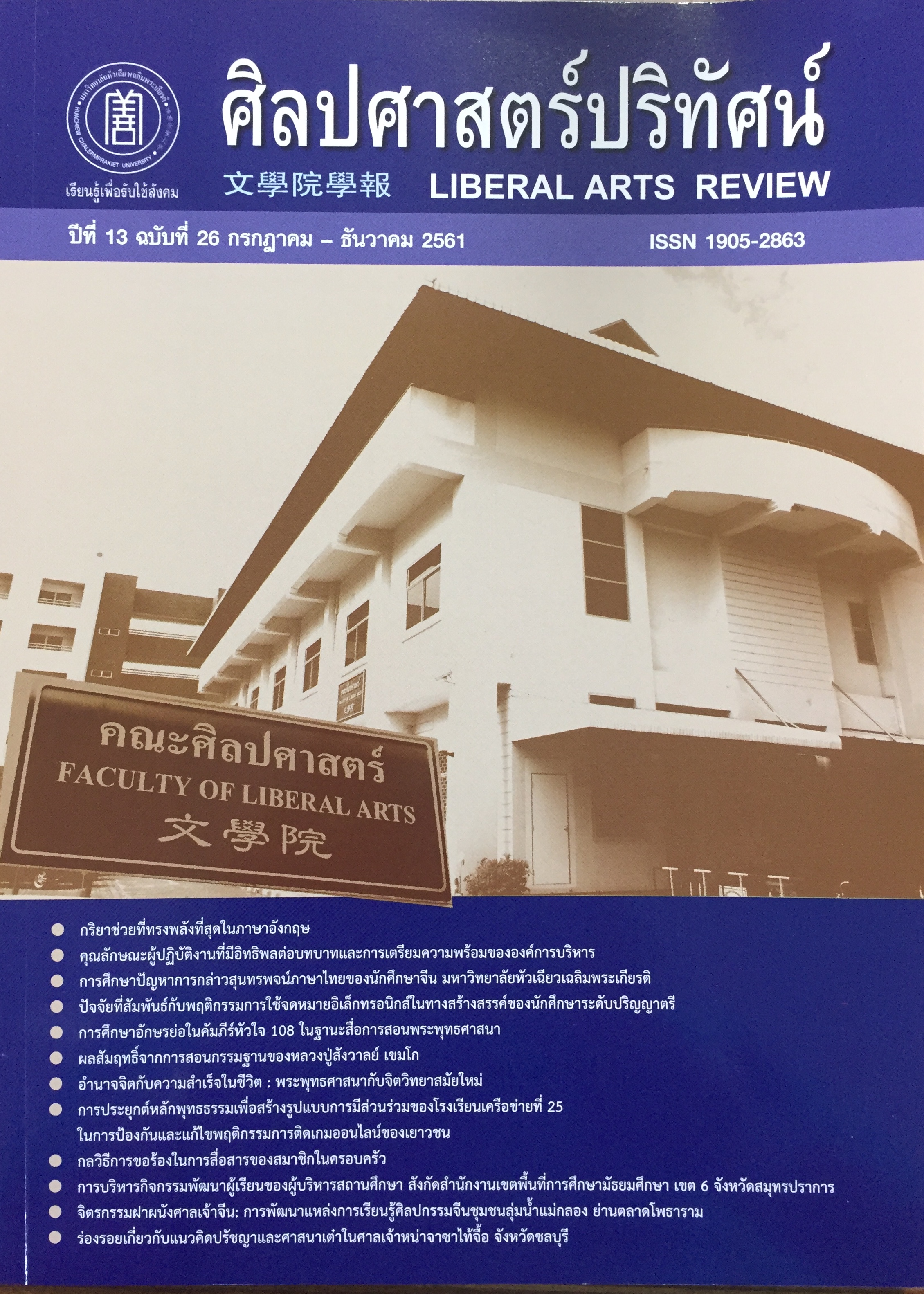A Study of Acronym in 108 Core Scripture as a Supplementary Buddhism Material
Keywords:
Acronyms, 108 Core Scripture, Buddhism MaterialAbstract
This research aimed to study the forms, the methods, the source material and
the use of acronyms in 108 core scripture as a supplementary Buddhism material using
the acronym theory as in the Wachirasãrattasangkhaha. This qualitative research collected
data from documents and in-depth interviews and they were analyzed and presented
as descriptive research report.
The research found 4 types of abbreviation of 108 core scripture which were
the abbreviation of the initial letter of a word (the most popular), the abbreviation of
the final letter of a word, the abbreviation of both the initial and final letter, and the
shortening the letter of a word and place it alternately. In addition, the abbreviation
was the mixing of both Thai and Pali words. The sources of most letter abbreviation
were scriptures, commentaries, supplications, and other scriptures which the wisdom
of the masters used them as learning media to convey important messages in Buddhism,
for instance, “Rattana Tri” or “Triple Gem” as well as Buddhist scriptures, rituals and
narratives in Buddhism. However, some core scriptures were derived from the belief in
Brahmanism, superstition, and Thai literature. In terms of application, the research found
that there were 2 ways of using the core scripture; 1) the application that corresponds
with the essence of the core scripture, which can be used for memorizing the principles
of Buddhism, for mental exercise to meditate by using the letters in prayer, and for the
leader reminder to leave baseness, observe the precepts, self-sacrifice, and mental
development, 2) the application that does not match the essence of the core scripture
by applying the acronyms in superstition, which are making the supernatural power
such as asking for safety and for great mercy and some people used them in the wrong
way, such as making people fall in love with or hate each other.
The result of this study answered the essence of Buddhism which had been
covered by the influence of superstition. This knowledge resulted in understanding
more about acronym in 108 core scriptures. Using appropriate knowledge can transmit
the Buddhism wisdom of traditional masters through the essence of the core scripture
to the younger generation as well.
References
กรุงเทพมหานคร : สมาคมผู้จัดพิมพ์และผู้จำหน่ายหนังสือแห่งประเทศไทย.
ฉ่ำ ทองคำสุวรรณ. (2529) “จารึกคาถาหัวใจพระสูตร” ใน จารึกในประเทศไทย เล่ม 5 : อักษรธรรม
และอักษรไทย พุทธศตวรรษที่ 19-25. กรุงเทพมหานคร : กรมศิลปากร.
เทพย์ สาริกบุตร. (2538) คัมภีร์หัวใจ 108. กรุงเทพมหานคร : เสริมวิทย์บรรณาคาร.
ธีรโชติ เกิดแก้ว. (2552) ศึกษาวิเคราะห์สัญลักษณ์ทางพระพุทธศาสนาที่ปรากฏในยันต์ไทย.
สมุทรปราการ : มหาวิทยาลัยหัวเฉียวเฉลิมพระเกียรติ.
ปรียา หิรัญประดิษฐ์. (2552) การใช้ภาษาไทยในวงศ์ราชการ. พิมพ์ครั้งที่ 3. กรุงเทพมหานคร :
ธรรกมลการพิมพ์.
พระครูวิสุทธิ์สมุทรคุณ (อนันต์ วิสุทฺโธ) ผู้ให้สัมภาษณ์. ธีรโชติ เกิดแก้ว เป็นผู้สัมภาษณ์. ที่วัดบางพลีน้อย
อำเภอบางบ่อ จังหวัดสมุทรปราการ เมื่อวันที่ 28 มีนาคม 2561.
พระครูสุคนธ์กิจจานุยุต (วีระ จนฺทูปโม) เป็นผู้ให้สัมภาษณ์. ธีรโชติ เกิดแก้ว เป็นผู้สัมภาษณ์. ที่วัดหอมศีล
อำเภอบางบ่อ จังหวัดสมุทรปราการ เมื่อวันที่ 29 มีนาคม 2561.
พระมหาปรม โอภาโส (กองคำ). (2541) ศึกษาวิเคราะห์ศรัทธาของชาวพุทธไทยในปัจจุบัน.
วิทยานิพนธ์ พธ.ม. (สาขาวิชาพระพุทธศาสนา) พระนครศรีอยุธยา : บัณฑิตวิทยาลัย มหาวิทยาลัย
มหาจุฬาลงกรณราชวิทยาลัย.
พระสิริรัตนปัญญา มหาเถระ. (ม.ป.ป.) วชิรสารตฺถสงฺคหํ ปกรณํ. ม.ป.ท. : ม.ป.พ.
พ่อปู่ไทรทอง. (2555) 59 พระคาถา ของขลัง อาคม คุณไสย์เขมร. กรุงเทพมหานคร : สัมปชัญญะ.
ภิญโญ ล่องสกุล เป็นผู้ให้สัมภาษณ์. ธีรโชติ เกิดแก้ว เป็นผู้สัมภาษณ์. ที่มูลนิธิภูมิพโล ภิกขุ เมื่อ 8 มีนาคม
2561.
มหาจุฬาลงกรณราชวิทยาลัย. (2515). พระไตรปิฎกภาษาบาลี ฉบับมหาจุฬาเตปิฏก 2500.
กรุงเทพมหานคร : โรงพิมพ์มหาจุฬาลงกรณราชวิทยาลัย.
_________. (2539) พระไตรปิฎกแปลภาษาไทย ฉบับมหาจุฬาลงกรณราชวิทยาลัย. กรุงเทพมหานคร
: โรงพิมพ์มหาจุฬาลงกรณราชวิทยาลัย.
ราชบัณฑิตยสถาน. (2538) สารานุกรมไทย ฉบับราชบัณฑิตยสถาน. กรุงเทพมหานคร : อรุณการพิมพ์.
ส. ศิวรักษ์. (2535) ความเข้าใจในพระพุทธเจ้าและมหาสาวิกาในสมัยพุทธกาล. พิมพ์ครั้งที่ 2.
กรุงเทพมหานคร : คณะกรรมการศาสนาเพื่อการพัฒนา.
สมชัย ฟักสุวรรณ เป็นผู้ให้สัมภาษณ์. ธีรโชติ เกิดแก้ว เป็นผู้สัมภาษณ์. ที่หอสมุดแห่งชาติ เมื่อวันที่
15 มีนาคม 2561.
สวัสดิ์ วิเศษวงษ์. (2525) ตำราเรียนอักษรโบราณ. กรุงเทพมหานคร : วงษ์สว่าง.
สำนักงานส.ธรรมภักดี. (ม.ป.ป.) เวทย์มนต์ 108. กรุงเทพมหานคร : ลูกส. ธรรมภักดี.
หัวใจ, ว่าด้วยหัวใจ 108 เป็นต้น. (ม.ป.ป.) กรุงเทพมหานคร : หอสมุดแห่งชาติ. เอกสารหมายเลข 490.
อุรคินทร์ วิริยะบูรณะ. (ม.ป.ป.) คัมภีร์ยันต์ 108 ฉบับพิสดาร. กรุงเทพมหานคร : ลูกส. ธรรมภักดี.
_________. (ม.ป.ป.) เพชรัตน์ มหายันต์ 108. กรุงเทพมหานคร : ลูกส. ธรรมภักดี.
University of Oxford. (2014) University of Oxford Style Guide: Michaelmas term 2014.
Wellington of Square, Oxford : University.
Downloads
Published
How to Cite
Issue
Section
License
บทความที่ได้รับการตีพิมพ์เป็นลิขสิทธิ์ของวารสารศิลปศาสตร์วิชาการและวิจัย
ข้อความที่ปรากฏในบทความแต่ละเรื่องในวารสารวิชาการเล่มนี้เป็นความคิดเห็นส่วนตัวของผู้เขียนแต่ละท่านไม่เกี่ยวข้องกับมหาวิทยาลัยหัวเฉียวเฉลิมพระเกียรติ และคณาจารย์ท่านอื่นๆ ในมหาวิทยาลัยฯ แต่อย่างใด ความรับผิดชอบองค์ประกอบทั้งหมดของบทความแต่ละเรื่องเป็นของผู้เขียนแต่ละท่าน หากมีความผิดพลาดใดๆ ผู้เขียนแต่ละท่านจะรับผิดชอบบทความของตนเองแต่ผู้เดียว




